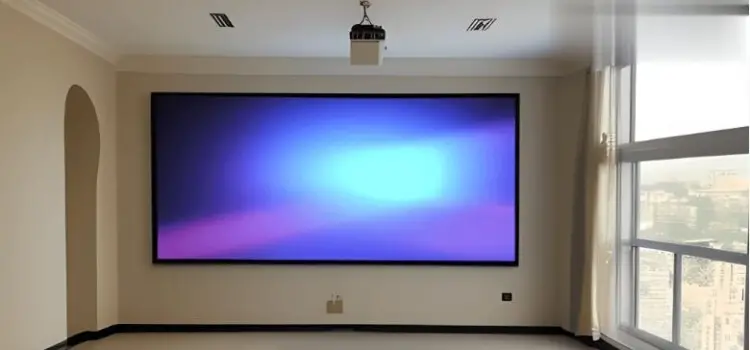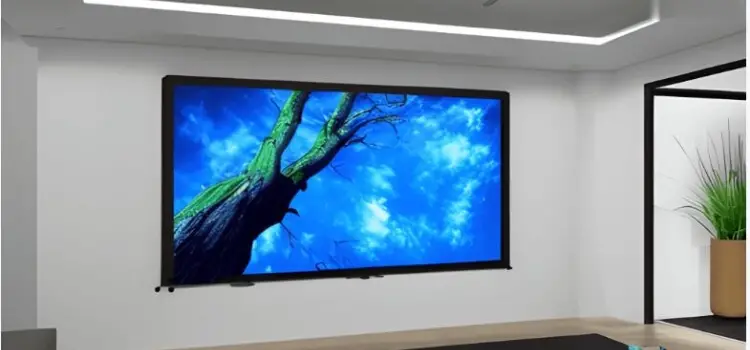As an Amazon Associate I earn from qualifying purchases.

With the increasing popularity of home theaters and the desire for immersive viewing experiences, many people are exploring different options for projecting movies, shows, and presentations onto their walls. One such option is projector screen paint, which claims to provide a cost-effective and space-saving alternative to traditional projector screens. In this article, we will examine the pros and cons of projector screen paint, consider important factors before using it, explore alternative options, and assess whether it is truly worth the investment.
Pros and Cons of Projector Screen Paint
Before delving deeper into the topic, understanding the benefits and drawbacks of projector screen paint is crucial. You can then decide based on your preferences and unique needs.
Advantages of Projector Screen Paint
- Cost-effective: Projector screen paint is generally more affordable than traditional screens, making it an attractive option for budget-conscious individuals.
- Space-saving: With projector screen paint, you can turn any wall into a projection surface, as the name says, doing away with the need for additional room to place a screen.
- Customizable size: With projector screen paint, you can choose the desired screen size, which can be applied to fit any wall dimensions.
- Easy installation: Applying projector screen paint is relatively straightforward and can be a DIY project for many homeowners.
Disadvantages of Projector Screen Paint
- Limited picture quality: While projector screen paint can provide decent results, it may not match high-end traditional screens’ image quality and performance.
- Room lighting conditions: Projector screen paint is more susceptible to ambient light, negatively impacting image clarity and contrast.
- Permanent solution: Once applied, projector screen paint becomes a permanent fixture on the wall, limiting your options for changing the projection setup in the future.
Factors to Consider Before Using Projector Screen Paint

Take into account the following facts before deciding if projector screen paint is the best option for you:
Room Environment
The lighting conditions in your room play a significant role in the performance of projector screen paint. Projector screen paint can provide satisfactory results if you control ambient light, such as in a dedicated home theater. However, traditional screens might be a better option if your room has large windows or is frequently exposed to natural light.
Projector Capabilities
The capabilities of your projector also need to be taken into account. Higher-end projectors with better brightness, contrast ratio, and color accuracy can compensate for some of the limitations of projector screen paint.
Personal Preferences
Ultimately, your personal preferences and priorities should guide your decision. Projector screen paint might be suitable for prioritizing cost-effectiveness and convenience over absolute picture quality. However, a traditional screen or an alternative option might be more appealing if you value the best image performance and have the budget.
Alternatives to Projector Screen Paint

If projector screen paint doesn’t align with your requirements, there are alternative options worth considering:
Traditional Projector Screens
Traditional projector screens are purpose-built for optimal image quality. They come in various types, such as retractable, fixed-frame, and motorized screens. These screens offer superior picture performance and wider viewing angles, and they often come with features like tensioning systems to ensure a flat surface.
Motorized Screens
Motorized screens provide the convenience of retracting when not in use. The screen may be made invisible with the push of a button, maintaining the aesthetics of the space. These screens are popular for dedicated home theaters and media rooms.
Fixed-Frame Screens
Fixed-frame screens offer a sleek and professional look. They are permanently mounted and provide a taut surface for an optimal viewing experience. Fixed-frame screens are typically used in dedicated home theaters and can enhance the room’s overall ambiance.
Cost Considerations
When evaluating the cost of projector screen paint, comparing it with traditional screens is essential to making an informed decision.
Price Comparison
Projector screen paint is generally more affordable than traditional screens, especially high-end ones. A projector screen paint kit costs significantly less than a motorized or fixed-frame screen. However, remember that you might need multiple coats of paint, increasing the overall cost.
Long-Term Cost Analysis
While projector screen paint may be cheaper upfront, consider the long-term cost implications. Traditional screens are more durable and can last years without significantly degrading picture quality. In contrast, projector screen paint may require touch-ups or recoating over time, adding to the maintenance cost.
Application and Installation Process
Applying projector screen paint requires careful preparation and attention to detail to achieve optimal results. To guarantee a successful installation, the following steps should be taken:
- Prepare the wall: Clean the wall thoroughly to ensure a smooth surface. Fill any cracks or imperfections and sand them down.
- Mask off the area: Use painter’s tape to create clean borders around the intended projection area.
- Apply primer: Apply a suitable primer to enhance the adhesion of the projector screen paint.
- Apply the paint: Follow the manufacturer’s instructions for applying the projector screen paint. Apply multiple coats if necessary, allowing sufficient drying time between each coat.
- Finishing touches: Once the paint is dry, remove the painter’s tape and inspect the surface for any touch-ups or corrections.
To ensure the best possible results, consult the projector screen paint manufacturer’s instructions.
Picture Quality and Performance

While projector screen paint can deliver satisfactory results, there are specific considerations regarding picture quality and performance:
Resolution and Image Clarity
Projector screen paint can support different resolutions, but the level of detail and sharpness might not be as precise as on a high-quality traditional screen. A dedicated screen might be better if you prioritize a crisp, detailed image.
Color Accuracy and Contrast
Projector screen paint can affect color accuracy and contrast. Traditional screens often have specialized coatings that enhance color reproduction and contrast, creating a more vibrant and dynamic image.
Viewing Angles
Projector screen paint typically has limited viewing angles compared to traditional screens. If you have a comprehensive seating arrangement or anticipate viewers watching from various positions, a traditional screen can offer better visibility for everyone in the room.
Maintenance and Durability
The durability of your projector screen paint depends on proper maintenance:
Cleaning and Upkeep
Cleaning projector screen paint is relatively simple. Dust the surface with a microfiber cloth or a gentle vacuum brush attachment. Avoid harsh chemicals or abrasive materials, which can damage the painted surface.
The lifespan of Projector Screen Paint
The quality of the paint, the humidity in the area, and maintenance practices may influence the service life of the paint on the projection screen. Projector screen paint can last several years with proper care but may require touch-ups or recoating to maintain optimal performance.
User Experiences and Reviews
Understanding the experiences of other users can provide valuable insights. Here are some common feedback points:
Positive Feedback from Users
- Users appreciate the cost-effectiveness of projector screen paint, especially for smaller budgets or temporary setups.
- Many users find the installation process easy and enjoyable, allowing them to customize their projection area to their preferred size.
Negative Feedback from Users
- Some users report issues with picture quality, such as reduced brightness and a lack of fine detail, compared to traditional screens.
- Ambient light can significantly impact the performance of projector screen paint, resulting in reduced image clarity and contrast.
Conclusion
In conclusion, projector screen paint can be a viable option for those seeking a cost-effective, space-saving solution for their projection needs. It offers advantages such as affordability, flexibility in sizing, and easy installation. Still, it’s essential to consider the limits, such as potential compromises in picture quality, susceptibility to ambient light, and the permanent nature of the solution.
Ultimately, the decision to use projector screen paint should be based on your specific requirements, budget, and preferences. If the optimal image quality is a priority and you have the budget, traditional screens or alternative options like motorized or fixed-frame screens might be a better fit.
FAQs
Yes, projector screen paint can be applied to most wall surfaces, including drywall, plaster, and textured walls. However, ensuring the surface is smooth and adequately prepared for optimal results is recommended.
The drying time for projector screen paint can vary depending on the product and environmental conditions. Following the manufacturer’s instructions regarding drying time and curing is essential for the best results.
Even though certain projector screen paints could be appropriate for outdoor use, it’s essential to consider elements like weather resistance and background illumination. Outdoor-specific projector screens are often a better choice for outdoor projections.
Projector screen paint can be used on textured walls, but the texture may affect the overall image quality. Smoother surfaces tend to provide better results. Testing a small area before applying projector screen paint to the entire wall is recommended.
Projector screen paint is a permanent solution; removing it may be challenging. If you decide to change your projection setup in the future, you may need to repaint the wall or consider alternative options.
Amazon and the Amazon logo are trademarks of Amazon.com, Inc, or its affiliates.
Leave a Reply